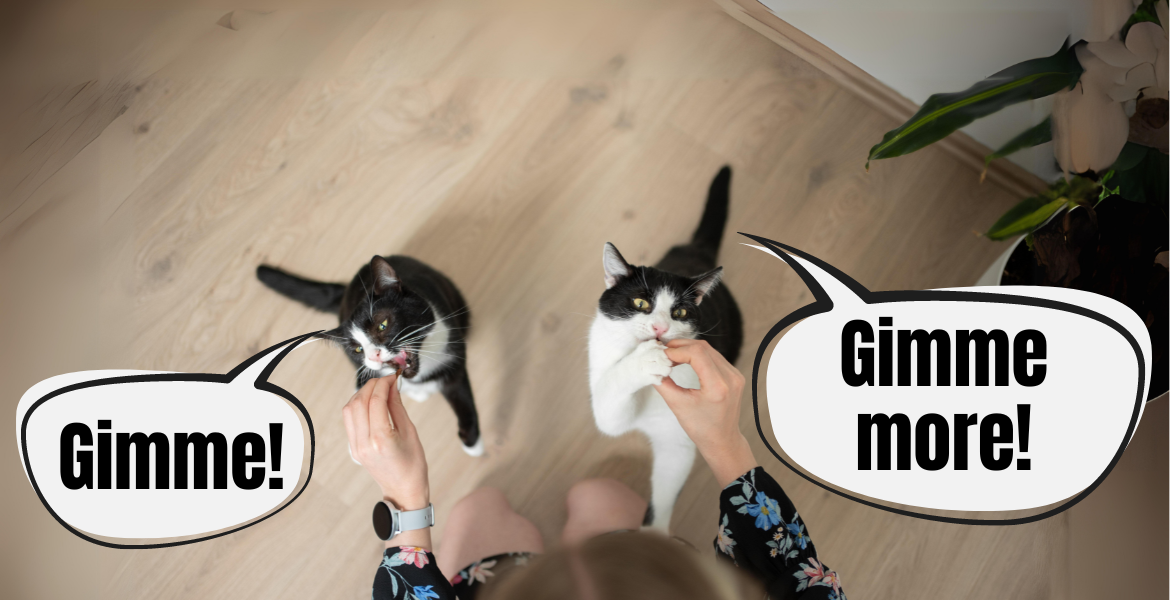If you were to place an open packet of your cat’s favorite treats in front of them and leave the room, the likelihood of it surviving is rather slim. Nothing strange about that – after all, snacks are irresistible! However, when all the cat’s senses are tuned to hunting down these delicious treats, it’s up to us, their fabCat Guardians, to ensure that our kitty doesn’t overindulge in them. So today, let’s talk about when it’s worth pampering our furry friends with tasty rewards and how many treats are TOO MANY. Let’s check it out together, fabCats.
Caloric Content of Cat Treats
Cat treats, even those with the best ingredients (such as dried meat), are not a complete diet. They’re just a snack, which although will be an attractive reward for your cat, shouldn’t make up the basis of their diet. From a nutritional standpoint, treats are simply extra calories – they shouldn’t account for more than 10% of the cat’s daily energy requirement (DER, i.e., the cat’s daily energy needs for active functioning). So, to prevent health problems (such as obesity), always include them in the planned calorie intake of all meals throughout the day and ensure that healthy, complete meals are the basis of the cat’s diet.
What does this mean in practice? If you have a bit of a knack for math, we recommend calculating the calorie content of treats and all the meals your cat consumes. The formulas necessary for such calculations can be found online, through cat dietitians, whose help we highly recommend. If, however, you don’t want to engage in calculations, it’s always worth checking the manufacturer’s recommendations on the packaging and sticking to the rule: too much of anything is unhealthy.
The Composition of Cat Treats Matters
Calories in treats don’t come out of thin air – each ingredient matters. So, if we’re already providing something extra to the cat’s diet, it’s worth doing it consciously. Obviously, we too sometimes indulge in chips, sweetened drinks, or something unhealthy, but we don’t do it every day. And with a more sensitive and significantly smaller body of a cat (compared to ours), you can never be too cautious. So what should we look for in cat treats? That which is healthiest for the cat, namely meat. The simpler the composition of treats, the better. Furballs don’t need an excess of carbohydrates in their diet, fillers like peas, starch, corn flour, plant products, milk, sugars, or animal by-products – these are just empty calories. Nicely packaged waste is still waste, although some cats will go crazy for them thanks to flavor enhancers.
What about treats in paste form? Here too, pay attention to the contents of the packaging – many readily available pastes, creams, and sauces are unfortunately far from ideal. Once again, we look for simplicity in the composition, limiting sugars and plant products. Sometimes, it’s just enough to look around well to find a better alternative 🙂
What to Reward Your Cat With Treats For?
If we were to ask the experts – those purring and furry ones – they would answer unanimously: for everything! However, such a scenario could quickly turn into teaching a cat to constantly beg for treats and inevitably get them, just so the Guardian can have some peace. It’s just better to act wisely here.
Treats are a valuable tool in working with cats – they can help overcome a cat’s fear and uncertainty, develop good habits in a cat, make unpleasant and disliked situations (such as trimming claws, grooming, or administering medication) more bearable, and also be part of play: a reward for successful hunting or an enticing treat in scent mats and puzzles that require the cat to activate all their senses to find it. Save the best ones, the ones your cat goes crazy for, for special occasions – let them feel that they’re willing to do anything for them, including voluntarily taking medication or jumping into a carrier. You can read more about how to use treats in working with cats on our blog: https://blog.mykotty.pl/en/2023/09/18/bribe-the-cat-how-to-use-treats-for-working-with-cats/
When to Say Enough to Your Kitty?
As we mentioned earlier: if it were up to the cat to dose treats, they’d likely be pouring out like a stream. That’s why the more we limit the situations in which our furries get treats, the easier it will be for us to say: STOP. Giving treats to a cat whenever they ask for it leads to the cat quickly getting used to the idea that they can get them on demand. And believe us: once accustomed, a cat will constantly demand them.
When serving treats to a cat, make it have a purpose. Whether you do it during training, play, or as a reward for good behavior – the cat must feel that it has earned the treat and recognize what they did well. The more we treat snacks as “something special,” the more motivated the cat will be to perform the task for which they deserve the treat. And remember, fabCats: a cat won’t be offended if they don’t get a treat. They won’t throw tantrums, destroy your furniture out of spite, or complain to the authorities. They may employ various tactics to get treats, especially if they previously received them without control. However, if you don’t give in, the cat will learn that coercion doesn’t work and will simply give up. And that will certainly be good for their health 🙂
How often and under what circumstances do you reward your furries with treats, fabCats? Or maybe you have some recommendations for good-quality and readily available treats that your cats absolutely love? Let us know in the comments!




